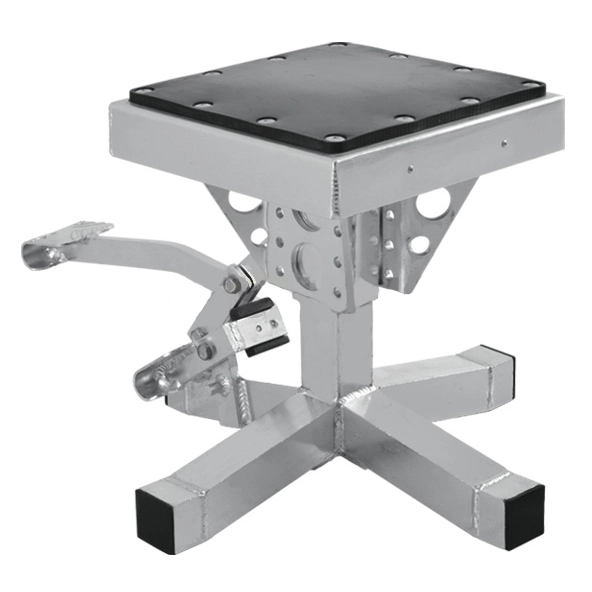Improper Positioning: The Foundation of Safe Lifting
Choosing the Wrong Surface
One of the most critical aspects of using a motorcycle lift stand is selecting the appropriate surface. Many riders make the mistake of setting up their stand on uneven or soft ground, which can lead to disastrous consequences. A stable, level surface is paramount for safe operation. Concrete floors in garages or workshops are ideal, providing a solid foundation for your lift stand. Avoid using the stand on grass, gravel, or any surface that might shift under pressure.
Incorrect Placement Under the Motorcycle
Another common error is placing the motorcycle lift stand in the wrong position under the motorcycle. Each bike model has specific lift points designed to support its weight safely. Failing to identify these points can result in damage to the frame, exhaust system, or other vital components. Always consult your motorcycle's manual to locate the correct lifting points. Some riders mistakenly place the stand under the engine or exhaust pipes, which can lead to costly repairs and potential injuries.
Neglecting to Center the Bike
Centering your motorcycle on the lift stand is crucial for maintaining balance during maintenance. Many enthusiasts overlook this step, assuming that as long as the bike is elevated, it's secure. However, an off-center placement can cause the motorcycle to lean or even topple when raised. Take the time to ensure your bike is perfectly centered on the stand before lifting. This simple precaution can prevent accidents and make your maintenance tasks much more manageable.
Ignoring Weight Distribution: A Balancing Act
Overloading the Stand
Every motorcycle lift stand has a maximum weight capacity, and exceeding this limit is a dangerous oversight. Some riders assume that if the stand can lift the bike, it can handle any additional weight. This misconception can lead to catastrophic failure of the lift mechanism. Always check the weight specifications of your stand and ensure your motorcycle falls within these limits. Remember to account for any additional weight from accessories or luggage that might be attached to your bike.
Uneven Weight Distribution
Proper weight distribution is essential when using a motorcycle stand lift. Many users fail to consider how the bike's weight shifts during maintenance tasks. For example, removing heavy components like wheels or the engine can dramatically alter the center of gravity. This change can cause the motorcycle to become unstable on the stand. Always be mindful of how your actions affect the bike's balance, and adjust the stand or use additional support as necessary.
Ignoring Side-to-Side Balance
While longitudinal balance is often considered, side-to-side balance is frequently overlooked. This oversight can be particularly problematic when working on fairings, saddlebags, or other side-mounted components. Ensure that your motorcycle is not only centered front-to-back but also side-to-side on the lift stand. This balanced approach will provide greater stability and reduce the risk of tipping, especially when applying force during maintenance tasks.
Overlooking Stability Checks: The Final Safeguard
Skipping Pre-Lift Inspections
Before elevating your motorcycle, it's crucial to perform a thorough inspection of your lift stand. Many riders skip this step, assuming that if the stand worked fine last time, it's still in good condition. However, wear and tear, loose bolts, or damaged components can compromise the stand's integrity. Always check for signs of wear, ensure all moving parts are properly lubricated, and verify that locking mechanisms are functioning correctly. This pre-lift ritual can prevent unexpected failures and protect both you and your motorcycle.
Neglecting to Test Stability
Once your motorcycle is on the motorcycle stand lift, it's tempting to immediately start working. However, neglecting to test the stability of the elevated bike is a common and potentially dangerous mistake. Before beginning any maintenance, gently rock the motorcycle to ensure it's secure on the stand. Pay attention to any wobbling or shifting, which could indicate an unstable setup. This simple test can reveal issues with positioning or weight distribution that might not be immediately apparent.
Forgetting Secondary Support
Even with a high-quality motorcycle lift stand, using secondary support measures is a wise precaution that many overlook. Jack stands, wheel chocks, or straps can provide an extra layer of safety, especially during extensive repairs or when working on heavier motorcycles. These additional supports can prevent catastrophic accidents if the primary lift stand fails. Always err on the side of caution and implement redundant safety measures to protect yourself and your valuable machine.
Conclusion
Mastering the use of a motorcycle lift stand is essential for safe and effective maintenance. By avoiding the common mistakes of improper positioning, ignoring weight distribution, and overlooking stability checks, you'll create a safer working environment and protect your investment. Remember that each lift operation is unique, and vigilance is key. Take the time to set up correctly, distribute weight evenly, and perform thorough stability checks. These practices will not only enhance your maintenance efficiency but also contribute to the longevity of both your motorcycle and lift stand.
Contact Us
For more information on our range of high-quality motorcycle lift stands and maintenance tools, contact RUNVA ENTERPRISES LIMITED at info@runva.com.cn. Let us help you elevate your motorcycle maintenance experience with our professional-grade equipment.

_1737625693698.webp)


